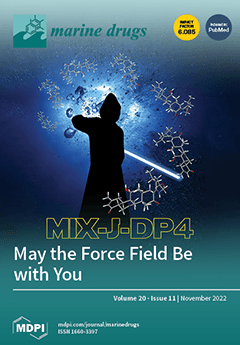Dietary supplements that promote healthy aging are mostly warranted in an aging society. Because of age-related risks, anti-inflammatory and anti-oxidative agents such as microalgae are potential candidates for intervention. In a randomized controlled trial, we tested
Phaeodactylum tricornutum (PT), a microalgae rich in
[...] Read more.
Dietary supplements that promote healthy aging are mostly warranted in an aging society. Because of age-related risks, anti-inflammatory and anti-oxidative agents such as microalgae are potential candidates for intervention. In a randomized controlled trial, we tested
Phaeodactylum tricornutum (PT), a microalgae rich in eicosapentaenoic acid (EPA), carotenoids, vitamins, and β-glucans, cultured in bioreactors. In this pilot trial, 19 healthy elderly received supplements for two weeks based on either the whole PT (
A), the β-1,3-glucan-rich PT supernatant (
SupB), the combination thereof (
A+SupB), or a Comparator product (
Comp). The primary outcome variable plasma interleukin-6 was reduced after treatment with
A+SupB compared to the
Comp group (
p = 0.04). The mobility parameters 5 s sit-to-stand test (
p = 0.04 in the
A group) and by trend gait speed (
p = 0.08 in the
A+SupB diet) were improved compared to
Comp. No treatment effects were observed for fatty acids, compared to
Comp but omega-6 to -3 fatty acid ratio (
p = 0.006) and arachidonic acid/EPA ratio (
p = 0.006) were reduced within group
A+SupB. Further, the
SupB study product reduced faecal zonulin (
p = 0.03) compared to the
Comp. The data revealed an anti-inflammatory and potentially anti-oxidative effect of particular PT preparations, suggesting that they might be suitable for effects in healthy elderly.
Full article






